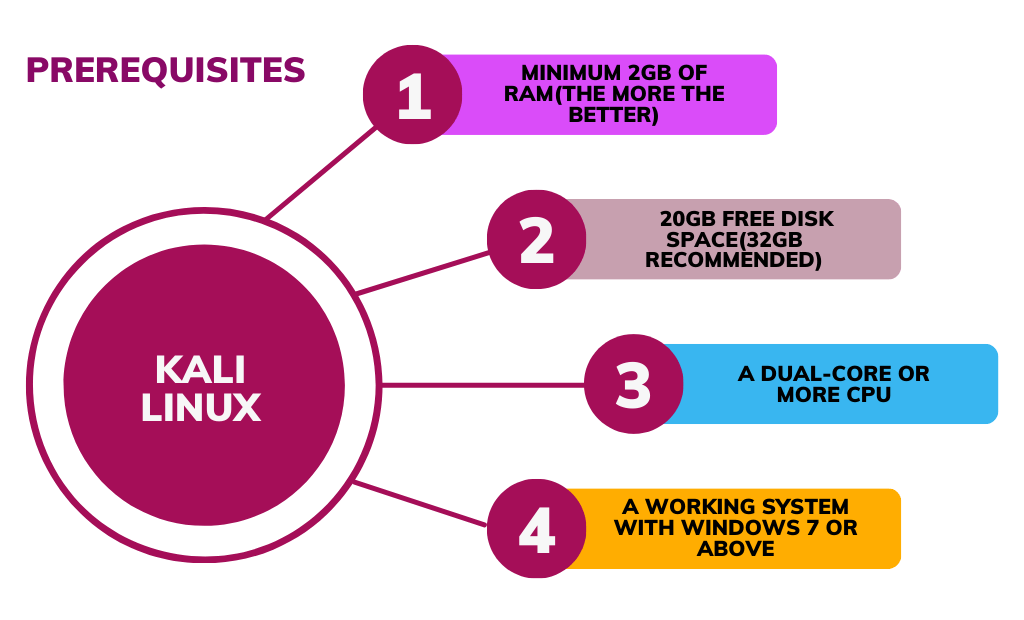
- What is Kali Linux?
- Who Uses Kali Linux?
- Prerequisites for Kali Linux
- Methods of Installing Kali Linux
- Basic commands in Kali Linux
- Top Kali Linux Tools
- Conclusion
Kali Linux is a powerful and widely-used operating system in the world of cybersecurity, penetration testing, and ethical hacking. In this step-by-step guide for beginners, we’ll introduce you to the fundamentals of Kali Linux, covering installation, essential tools, basic commands, and how it fits into Cyber Security Training Courses. Whether you’re new to Linux or just starting with ethical hacking, this tutorial will provide you with the knowledge to get started and explore the capabilities of this advanced OS in a simple and accessible way.
Interested in Obtaining Your Kali Linux Certificate? View The Cyber Security Online Training Offered By ACTE Right Now!
What is Kali Linux?
Also known as BackTrack Linux, it’s a Debian-based security distribution in Linux especially designed to perform ethical hacking operations such as penetration testing, cyber forensics, advanced scanning, reverse engineering, and security auditing. It features hundreds of pre-installed tools that make it the best choice for Ethical Hacking and tech enthusiasts who want to perform security testing. Linux is a multi-platform solution for both cybersecurity professionals and tech enthusiasts that provides all the necessary tools required to automate tasks that would otherwise be very difficult to perform manually, such as those involved in a Maze Ransomware Overview and Impact. For example, while performing penetration testing or Security Testing or hacking, you might have to apply different combinations with thousands of values to penetrate the system. These tasks cannot be performed manually, instead, you require some tools to automate the tasks. Such tools not only save your time and effort but also produce the desired results by collecting accurate results.
- Kernel:The kernel is the core of an operating system that manages all the operations related to the hardware. It acts as a communication bridge between hardware and the user who wants to utilize the CPU and I/O devices for specific tasks.
- Shell: Shell on the other hand is an environment or interface that executes various programs based on the inputs provided by the user who wants to utilize the operating system services.
There are two major components of Kali Linux:
Who Uses Kali Linux?
Following are the professionals who utilize Kali Linux to perform various operations and describe the best use of Kali Linux:
- Network Administrators: Network administrators use Linux to detect and eradicate rogue access points, audit their network, and maintain security. And simulate attacks on their network to find potential vulnerabilities.
- Security Administrators: These professionals are responsible for protecting valuable information and institutional data from unauthorized visitors. A security administrator uses Linux tools for Security Testing the environment and discovers vulnerabilities that might pose a threat to the data in the future.
- Network Architect: They use Linux to find the hidden flaws in the architecture and design a secure network environment. Also, they use it to test the environment and see if there is any misconfiguration that has been overlooked in the network infrastructure, a process commonly known as VAPT.
- Pen Testers: Pentesters are the cybersecurity experts whom an organization hires to review its infrastructure and find vulnerabilities or flaws within the network. A Pentester uses Linux to perform penetration testing and audit the environment for which he is hired to review.
- Forensic Engineer: Forensic engineers leverage Linux’s ‘forensic mode’ to discover the missing data and recover it safely back to the system. They also design data backup strategies for the organization so that the data can be safely recovered in case a cyberattack happens.
- CISCO: The chief information security officers utilize Kali Linux resources to audit the environment both internally and externally to discover rouge configurations and applications that have been released in the system and might compromise it.
- Black Hat Hackers: These are the bad guys you see in the movies trying to hack into a facility or break the government’s security and control over the infrastructure. They generally use Kali Linux to discover the vulnerabilities and infiltrate them into the system.
- White Hat Hackers: Opposite to black hat hackers, these are the good guys using the same tools and expertise to discover any vulnerabilities and prevent or stop the attack in the early stages.
- Computer Enthusiasts: It’s a generic term given to the people like you and me, who are interested in hacking, penetration testing or Security Testing and learning new technologies. Computer enthusiasts or hobbyists use Linux to learn more about networking, cybersecurity, vulnerabilities, operating systems, and information security.
- Directly on a Laptop/PC: If you’re already familiar with the operating system, installing Linux on your spare PC or laptop will be the best way to enhance your skills for Cyber Security Training Courses. It will also help you perform access point testing and other operations. You can easily download the ISO image from the Kali Linux website and install it.
- Through Virtualization: Virtualization refers to the process of simulating a virtual hardware system that provides the ability to run multiple operating systems or applications on a single computer/server. This enables you to utilize the available resources more efficiently. Now, Linux provides pre-configured OS images that support most known virtual machines like Hyper-V, Oracle, Citrix, VMware,VirtualizationBox, etc. Running Linux on a virtual machine is the best way of using it if you want to clear Kali Linux basics or just want to explore the Kali Linux commands.
- Dual Boot(for both Windows and Mac): Dual boot means running two operating systems on a single machine without using a third software or application like VMware or VirtualizationBox. You can create a boot disc in a USB flash drive and use Kali Linux as a secondary operating system. It will ask you to select one operating system whenever you power ON on your computer/laptop.
- Windows 10(App): This is the latest method for using two different operating systems on a single computer. Kali Linux can now run on Windows 10 as an application through the command-line interface. However, the application is still in beta mode and is best for beginners. Now, let’s move on to the next part and install Kali Linux using VirtualizationBox. The process of how to install Kali Linux on VMware is almost the same as VirtualizationBox. So, we’ll not be showing the process for both.
- Date command: The date command is used to display and often set the date and time of your system. However, you should have the administrator’s right to change the date and time.
- Cal command: The Cal command in Linux is used to display the calendar. For an advanced version of the calendar, you need to add the ‘local’ package
- pwd command: The print Working Directory or pwd command prints the name of the working directory, which can be useful when analyzing Active and Passive Attacks in a network environment.
- ls command: The ls command is one of the most useful commands in Linux that displays all the content of the directories and files. It will also show you the content that would otherwise be hidden. Remember, the command has ‘L’ not ‘I’. Also, the output will be different for different systems.
- cd command: The command allows you to change the directory or go back from the current directory.
- mkdir command: This command is used to create a new directory from the command line in a specific location.
- Open the command prompt and type in: Sud apt-get install nmap
- After the installation, type ifconfig on the command prompt. This will show all the hosts connected to your device. Then type: Nmap [hostname or IP address] This command will display all the details captured by the host discovery.
- Metasploit: Metasploit is a penetration testing framework that comes pre-installed with Kali Linux and is an open-source tool. It’s mainly used for port forwarding and exploiting any vulnerabilities in a local network. It also comes with a GUI package named ‘Armitage’ which makes it more feasible and convenient to use. To use Metasploit, you just have to type ‘msfconsole’ in the command prompt and the Metasploit framework will be activated.
- Netcat: Netcat is yet another open-source tool that comes pre-installed in Kali Linux. This networking tool is used for network debugging, port scanning, port, listening, port redirection, and network daemon testing. It is sometimes also called the master of all networking tools as it can do operations related to UNIX domain sockets, TCP, UP, remote connections, and much more.
To Earn Your Kali Linux Certification, Gain Insights From Leading Kali Linux Experts And Advance Your Career With ACTE’s Cyber Security Online Training Today!
Prerequisites for Kali Linux
Anyone with knowledge of computer fundamentals can start learning Kali Linux. For installation, your system must fulfill the following requirements: Minimum 2GB of RAM (the more, the better), 20GB free disk space (32GB recommended), a dual-core or more CPU, and a working system with Windows 7 or above, especially when you’re installing Linux on a VirtualizationBox or VMware. Once installed, you can start exploring essential tools like Nmap Commands for network scanning and security assessments.

Once your system meets the minimum requirements, the installation process for Kali Linux is straightforward. You can choose to install it on a virtual machine using tools like VirtualBox or VMware for a safe, isolated environment. Alternatively, Kali Linux can also be installed directly on your hard drive, offering full system access. The installation involves creating a bootable USB drive, configuring basic settings, and following on-screen prompts. After installation, you’ll be ready to explore Kali Linux’s wide range of penetration testing tools, from network scanning to vulnerability assessments, allowing you to sharpen your cybersecurity skills.
Methods of Installing Kali Linux
There are mainly four methods to install or how to use the Kali Linux operating system on your device:
Gain Your Master’s Certification in Cybersecurity by Enrolling in Our Cyber Security Expert Masters Program Training Course.
Basic Commands in Kali Linux
Before you start working on advanced tools and frameworks, we recommend you first get familiar with some Linux basic commands. Following are the basic commands in Kali Linux that make your work much easier:
Top Kali Linux Tools
Following are some of the important tools that Kali Linux provides to perform penetration testing, access points, and hacking: The first step in penetration testing or hacking is gathering as much information as possible about your target. This includes information about routers, connected devices, null access points, networks, and firewalls. Also known as digital reconnaissance, it helps you find the vulnerabilities in the system while keeping your identity hidden. The best tool for digital reconnaissance in Kali Linux is Nmap. It’s an open-source network scanner that can perform all types of scans to help the user find ports, fingerprint the network, and discover hosts on the network, making it an essential tool for IP Security assessments. Nmap gives you the result by sending the packets to the host and analyzing them. Follow the steps below to perform the reconnaissance and scan open ports:

Preparing for Cyber Security Job Interviews? Have a Look at Our Blog on Cyber Security Interview Questions and Answers To Ace Your Interview!
Conclusion
In conclusion, Kali Linux stands as one of the most powerful and widely used tools for penetration testing, ethical hacking and cybersecurity research. Its extensive suite of pre-installed tools, coupled with its open-source nature, makes it an indispensable platform for security professionals and enthusiasts alike, especially those enrolled in Cyber Security Training Courses. Kali Linux enables users to identify vulnerabilities, simulate cyberattacks, and reinforce the security posture of systems, contributing significantly to the field of cybersecurity Forensics.





